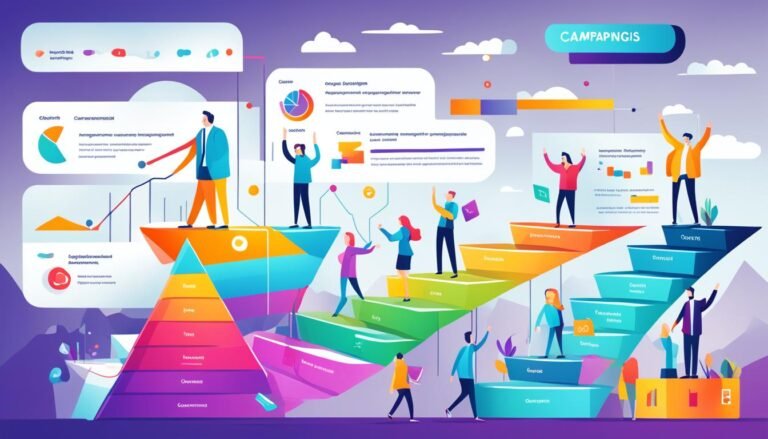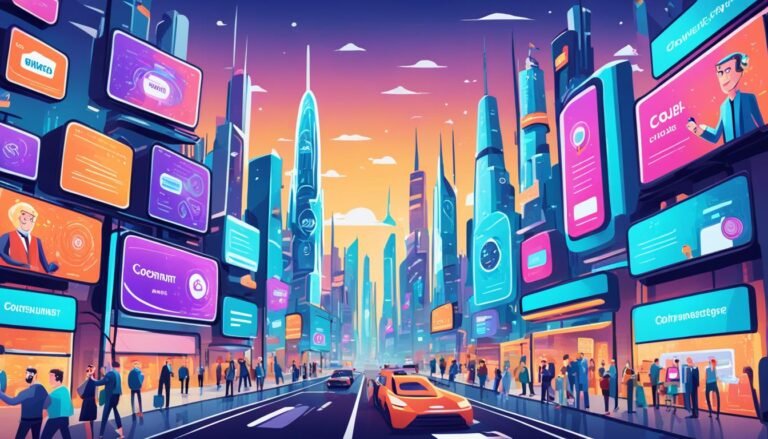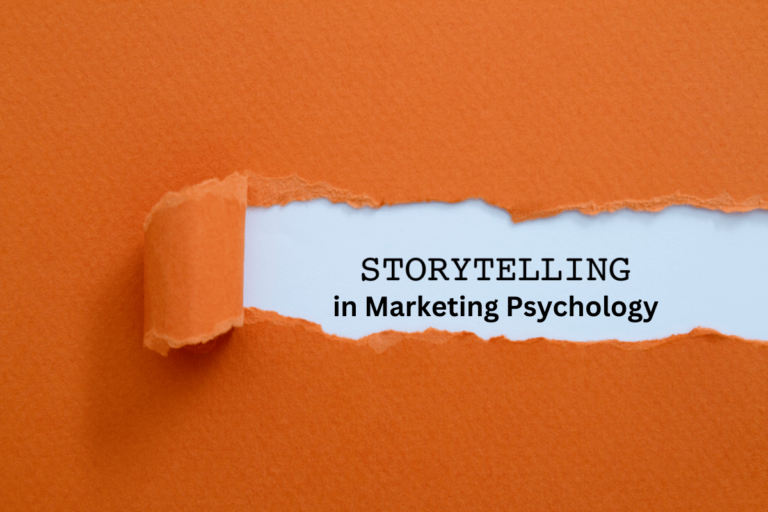The Future of Advertising: Traditional vs. Digital
Did you know that 95% of people look up financial advisors online before choosing one? This shows how advertising is changing fast. Companies now need to use both traditional and digital ways to stay in the game. Traditional ads like print, radio, and TV still win hearts with their charm. But digital ads offer a huge reach, customization, and clear results.
Using both traditional and digital marketing brings its own set of challenges and chances. Digital tools like big data and AI make traditional ads more precise, targeting specific people’s interests. This mix is key to keeping people interested across different groups.
Key Takeaways
- 95% of prospects research financial advisors online before engaging their services.
- Big data analytics and AI will enhance the impact of traditional advertising.
- Integration of interactive TV ads, AR in print media, and innovative radio podcasts marks the fusion of traditional and digital marketing.
- Stricter regulations on data usage will shape the future of traditional advertising.
- Combining offline and online strategies, like using QR codes and social media tie-ins, will bridge the gap between traditional and digital worlds.
Introduction to Traditional Advertising
Traditional advertising is still important in marketing. It uses methods we see every day, like billboards and TV and radio ads. These strategies are key to traditional marketing. They work well with both new and local audiences.
What is Traditional Marketing?
Traditional marketing uses offline ways to promote products and services widely. This includes mail, TV commercials, radio ads, and print media. These methods create a strong connection with people, often more so than online ads. They are great at building trust and credibility, especially in local areas where personal touch matters a lot.
Common Traditional Marketing Methods
Many traditional marketing methods are still popular because they work well. Here are some of the most common ones:
- Television Commercials: These ads grab a wide audience with their visuals and sounds, leaving a strong impact.
- Radio Ads: Radio reaches people during their daily activities or while driving, making it a versatile way to advertise.
- Direct Mail: Direct mail sends messages right to people’s homes, offering a personal touch that’s often valued.
- Print Media: Newspapers, magazines, and brochures let readers take their time to engage with the content.
- Billboards: Billboards catch the eye of people walking by or driving, making sure the message gets noticed.
Traditional marketing might seem old-school and costly, but it’s still valuable. It’s especially good for reaching older folks and those who don’t use digital much.
Introduction to Digital Marketing
Digital marketing has changed how businesses reach out to people. It uses new technology for more effective campaigns. With 4.95 billion people online, there are huge chances for marketers to connect with many people using new digital strategies.
What is Digital Marketing?
Digital marketing uses electronic devices or the internet for marketing. Brands use digital channels like search engines, social media, email, and websites to promote their products. This approach lets brands reach people all over the world and talk back to them quickly.
It also lets marketers see how well their campaigns are doing and make changes fast.
Forms of Digital Marketing
There are many ways to connect with people online today. Some main types of digital marketing are:
- Social Media Marketing: With 4.62 billion users, social media sites like Facebook, Instagram, Twitter, and LinkedIn let brands talk to their audience with posts, videos, and stories.
- Pay-Per-Click (PPC): This method pays for each ad click. It helps brands target their audience well and manage their budget.
- Mobile Marketing: With everyone having smartphones, mobile marketing uses SMS, MMS, in-app ads, and mobile websites to reach users.
- Content Marketing: Making valuable content draws in and keeps an audience interested. It helps build trust and loyalty to a brand.
Also, digital marketing lets businesses see how well their ads are doing with advanced analytics. This helps make campaigns better and understand what customers like.
As the digital world keeps changing, using strong digital marketing plans is key for businesses to stay ahead and grow.
Comparing Engagement: Traditional vs. Digital
Traditional and digital marketing have big differences in how they engage audiences. Traditional methods like TV, radio, and print reach a lot of people but don’t really get them involved. Digital marketing uses the internet and social media to reach more people and get them to interact more.
Audience Reach and Interaction
Traditional marketing is great at quickly reaching a lot of people. For instance, TV ads in North America spent about $65 billion in 2020. But, digital marketing lets brands talk directly to people. Social media lets businesses chat with customers right away, offering quick feedback and conversations.
Did you know 49% of people aged 18 to 29 bought something after seeing a social media ad? Digital marketing can also target specific groups with messages, making interactions better.
Engagement Metrics
Digital marketing gives us detailed insights on how well campaigns are doing. We can track things like clicks, time on page, and social media interactions. This helps businesses make smart choices and improve their strategies.
Traditional marketing can’t match the detail digital marketing offers. While 75% of people remember brands from direct mail, it’s hard to measure how much they’re really engaged. Digital marketing gets 50% more customer interactions than traditional methods and tracks results in real-time. This makes it a more flexible and quick way for businesses to connect with people.
The Future of Advertising: Traditional vs. Digital
The future of advertising mixes old and new ways to reach people. Traditional methods like TV, radio, and billboards are now part of digital plans. These old ways still work well for making brands known to many people.
Digital marketing is changing the game with its two-way talks. It uses social media, email, and SEO to talk directly to customers. This way, it builds relationships and gets quick feedback, making it key for today’s marketers.
Programmatic advertising and influencer marketing are big in digital ads. Programmatic ads use data to buy ads automatically, targeting specific people. Influencer marketing uses famous people to promote products, boosting engagement and sales.
Digital marketing is better at tracking and analyzing data. Tools like Google Analytics show how well ads are doing. This helps marketers make smart choices based on real data.
Traditional ads still reach a lot of people, especially through TV. They use sound and sight to make a strong impression. Even though they cost more, many businesses choose them to build brand awareness. Studies show that paper ads can motivate people more than online ones.
Now, ads are blending traditional and digital methods. This mix helps businesses reach different people well. As we go deeper into the digital age, using both old and new ways of advertising will become even more important. It helps businesses stay up-to-date with how people behave and change.
Data-Driven Campaigns and Personalization
In today’s fast-paced digital world, data-driven marketing campaigns are key for brands to succeed. They use consumer data and analytics for personalized experiences. This way, marketers can make ads that speak to specific people’s interests and needs.
Personalized marketing has big benefits. Ads that match what people like get more attention, which means more people engage with them. For instance, personalized emails can get up to five times more clicks than general emails. This is because they’re made just for the person, using what they’ve done before.
Online behavioral advertising (OBA) takes this even further by showing ads based on what people do online. Yes, there are privacy concerns, but most people find these ads helpful. They’re more likely to accept them because they’re right on target.
Lego is a great example of how data-driven strategies work. In October 2023, they spent over $900K on ads in the U.S. aimed at adults. They used data to find out what adults like and needed. This helped them reach more people and sell more to them.
To get the most from data-driven campaigns, companies should use lots of data. This includes search data, what people browse, and what they’ve bought before. Social media and the Google Display Network are great places to find your audience. Predictive analytics can also help make your marketing better by learning from past campaigns.
Cost Efficiency: Traditional vs. Digital
In today’s fast-changing ad world, it’s key to look at cost efficiency between old and new marketing ways. Traditional ads like TV, radio, and print have long been popular. But, digital marketing is now a cheaper and smarter choice.
Investment Returns
There’s a big difference in investment returns between old and new marketing. For example, reaching 1,000 people with TV ads costs about $7. But, Facebook Ads only cost $0.25 for the same audience. This shows how digital ads are more cost-effective.
TV ads in top timeslots can cost millions for just 30 seconds. This makes them too expensive for many businesses. Digital marketing, on the other hand, lets businesses track their investment returns easily. This means they can make changes quickly and save money, leading to better returns.
Measuring Effectiveness
Digital marketing has a big edge over traditional in effectiveness measurement. It uses detailed analytics to track user actions and results. This lets marketers see how well a campaign is doing and adjust it for better results.
Traditional marketing is harder to measure. It’s tough to know how many people saw an ad or what they did after seeing it. Unlike digital, traditional marketing plans are set early and can’t easily change, making it harder to see success.
Traditional marketing has its benefits, but digital marketing wins in cost efficiency, investment returns, and effectiveness measurement. Digital marketing’s flexibility and real-time data make it a key tool for today’s advertisers.
Omnichannel Strategies in Modern Advertising
In today’s fast-changing ad world, using omnichannel strategies is key for businesses. They aim to give customers a great customer experience. By mixing old and new ways of advertising, brands can send the same message everywhere. This helps build stronger customer loyalty.
Integration of Digital and Traditional Platforms
Good platform integration lets businesses use the best of old and new ads. For example, using local TV ads with social media gets more people involved and keeps them interested. Most retailers, 87%, see omnichannel marketing as crucial for success.
Using both kinds of ads also helps get past the noise and build trust, as 82% trust print ads. This mix makes ads more effective.
Creating Seamless Customer Experiences
For a smooth customer experience, knowing what customers like and do is key. Knowing who they are, what they buy, and how they use technology is important. Brands send the same message everywhere to make sure customers feel connected.
Companies like Starbucks use this strategy well. They fix customer problems with a strong omnichannel plan. This makes shopping better and customers happier.
Also, customers who use more channels spend 9% more in stores than those with just one channel. This shows the money benefits of a good mix of old and new ads. Marketers are putting more money into both kinds of ads. They know a varied strategy helps reach more people.
Innovative Trends in Digital Marketing
In the fast-paced world of digital marketing, new trends keep changing the game. With over 5.19 billion Internet users worldwide, digital marketing is key for businesses. Influencer marketing has become a big deal, helping brands reach specific audiences well.
This shift has changed how companies reach and connect with customers. Gone are the days of traditional ads like billboards and radio. Now, digital platforms offer a smarter and cheaper way to advertise. Influencer marketing is especially powerful for creating real connections and promoting brands through trusted voices.
Video content and content marketing have grown in importance. Companies use these to increase their online presence and generate leads. By 2024, digital ads are expected to hit $740.3 billion, with mobile ads reaching 4.8 billion people worldwide.
AI-powered tools are taking digital marketing to new heights. The AUDIENCEX Intelligence (AXi) suite helps create personalized marketing campaigns. This leads to better engagement and more conversions. These innovative digital trends let marketers make smart decisions with real-time data, adjusting budgets for the best results.
AR and VR technologies are also changing the game, making digital campaigns more engaging. They improve customer experiences and how people interact with brands. With a mix of influencer marketing and social media, brands can reach a wide and diverse audience, going beyond old-school methods.
Companies are now spending a big chunk of their budgets—11% to 50%—on content marketing. They see its value in building brand loyalty and getting customers to act. As digital trends keep evolving, businesses need to stay flexible and up-to-date to stay ahead in the digital world.
Conclusion
The future of advertising will mix old and new ways. Traditional marketing has always been key for brands, using print ads, radio, and mail to reach people. These methods work well with local audiences, giving them something they can touch and trust. Older people like this kind of communication.
But, digital marketing has changed everything. It lets businesses talk to people all over the world with great accuracy. Tools like social media, search engines, emails, and videos are fast and let companies know how well they’re doing. They can see exactly how many people are looking at their ads.
Now, the best way to advertise is a mix of old and new. Companies need to use both to reach more people. Making content that grabs attention online is crucial. At the same time, traditional marketing still has a lot to offer. As things change, knowing how to use both will be key to success in advertising.
Source Links
- The Future of Traditional Advertising: An Insight into What Lies Ahead
- Digital Meets Traditional: The Future of Marketing – Oechsli
- The Difference Between Digital and Traditional Advertising
- Traditional Marketing vs. Digital Marketing: Navigating the Modern Landscape
- Traditional Marketing vs. Digital Marketing: A Comparative Analysis
- Traditional Marketing vs. Digital Marketing [2023 Edition] | Simplilearn
- Traditional Marketing vs. Digital Marketing
- TOP DIGITAL MARKETING VS TRADITIONAL MARKETING STATISTICS IN 2023 | Amra And Elma LLC
- Digital Marketing vs Traditional Marketing : What’s The Difference?
- The Future of Marketing: Digital vs. Traditional
- Advertising’s Future: Blending Digital and Traditional Methods – Search My Expert Blog
- How to find the right balance of traditional marketing vs digital marketing? See the benefits of all marketing and how both can work together for you.
- Data-driven digital advertising: benefits and risks of online behavioral advertising
- What is Data-Driven Advertising? Definition, Strategies, & Trends
- What Is Data-Driven Marketing & Why Is It Important?
- Digital vs Traditional Marketing: Which One to Choose? | VEVS Blog
- Traditional Marketing vs Digital Marketing | elk marketing
- Digital Marketing vs. Traditional Marketing: A Comprehensive Comparison in 2023
- Omnichannel Marketing: A Complete Guide for 2024 and Beyond
- How To Integrate Traditional and Digital Advertising
- Traditional Marketing Vs Digital Marketing: Which is Better?
- From Traditional to Digital: Exploring the Shift in Marketing Strategies
- The Future Of Advertising and What To Expect In The Coming Years
- Traditional Marketing vs. Digital Marketing: Which Reigns Supreme? – AMW
- Why Digital Marketing is Outpacing Traditional Marketing







